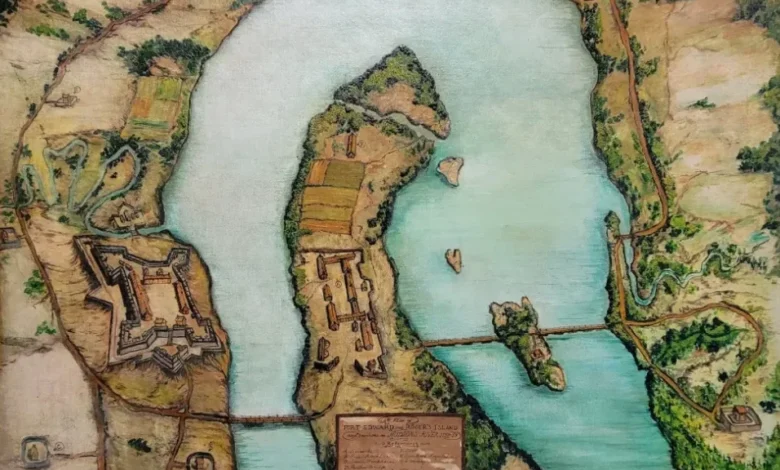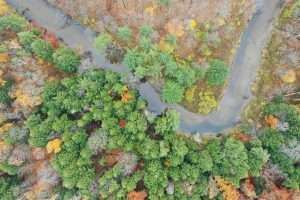Heritage Profile: Fort Edward & Rogers Island in the Hudson River


 Native Americans began hunting and fishing on Rogers Island and along the Hudson River in what would later become the town of Fort Edward in Washington County, NY, at least 6,000 years ago.
Native Americans began hunting and fishing on Rogers Island and along the Hudson River in what would later become the town of Fort Edward in Washington County, NY, at least 6,000 years ago.
Archaeologists working there have unearthed thousands of stone tools, pottery sherds and other artifacts as well as features like hearths from the Late Archaic, Transitional, Middle Woodland and Late Woodland Periods. These first indigenous inhabitants left behind their hearths, trash pits, stone tools, and pottery as they hunted, fished and traveled in the area.
Prior to the arrival of Europeans, local people referred to the area around Fort Edward as Wahcoloosencoochaleva, The Great Carrying Place. The Hudson River is not navigable north of Fort Edward due to waterfalls and rapids, making further travel by water impossible.
To continue to the north, Native Americans carried their canoes overland to Lake George or Lake Champlain. This path to the north was part of a route through the Hudson and Champlain Valleys know as the “Great War Path”
Military Forts
Fort Edward was not the first fortification built during the colonial era. Fort Nicholson, a stockade built in 1709 during Queen Anne’s War 1701-1713 was garrisoned by as many as 450 men. After its abandonment Fort Lydius was constructed as a trading post by John Henry Lydius in 1731.
During the French & Indian War (1754-1763), Fort Lyman was built under the direction of General Phineas Lyman on the east bank of the Hudson River.

 On September 21, 1755 it was renamed renamed Fort Edward in honor of Prince Edward, the grandson of King George II and younger brother of King George III.
On September 21, 1755 it was renamed renamed Fort Edward in honor of Prince Edward, the grandson of King George II and younger brother of King George III.
During the French & Indian War, Fort Edward and Rogers Island’s strategic location led to the construction of one of the largest British military complexes in North America. Construction extended to what would come to be called Rogers Island where additional barracks, storage buildings, hospitals and a blockhouse were built.
Thousands of troops encamped in and around the fort, on the banks of the Hudson and on Rogers Island adjacent to the fort. Fort Edward eventually became the staging ground for invasions northward into French Canada by the British and provincial troops who would eventually drive the French out of New France.
During the height of troop build-up in 1757, when the population was estimated at 16,000, Fort Edward was the third largest city in the colonies behind only New York and Boston.
Philip Schuyler, Israel Putnam and Paul Revere were all stationed at Fort Edward during the French and Indian War before becoming officers in the Revolutionary War. Although there was never a battle fought on Rogers Island, it was the largest hospital complex, supplies depot and training base of the war.
From 1756 to 1759 Rogers Island was the base camp for Major Robert Rogers and his company of Rangers. On October 25, 1757, Rogers wrote to General John Campbell, 4th Earl of Loudoun detailing his “Ranging Rules” which instructed his men on forest warfare based on tactics he developed from fighting methods used by Native Americans.
This new method of training and rules of order were very different than the methods the British used on the battlefield. Irregular fighting forces would later use his rules, which would become more commonly known as standing orders, as the basis of military tactics around the world. His rules are still the standing orders in use by the U.S. Army Rangers today.

 In 1766, after the French & Indian War was over, Fort Edward was ordered evacuated and its stores were moved to the British fort at Crown Point, leaving Fort Edward to decay.
In 1766, after the French & Indian War was over, Fort Edward was ordered evacuated and its stores were moved to the British fort at Crown Point, leaving Fort Edward to decay.
Although the fort itself was in ruins during the Revolutionary War, Fort Edward remained strategically located on the Great Military Warpath and troops garrisoned in the remaining barracks on the island. In 1777 they were forced to flee when General John Burgoyne’s army passed through en route to the Battles of Saratoga.
Rogers Island Visitors Center
The Rogers Island Visitors Center (RIVC) opened to the public on July 6, 2001 on historic Rogers Island in the middle Hudson River across from the modern Village of Fort Edward.
Housed in a fully handicapped accessible building, the exhibits within the RIVC tell of Fort Edward’s and Rogers Island’s histories, about the area’s earliest known Native American inhabitants and Fort Edward’s important role in the French & Indian War and early American history. It also explores what life was like for the soldiers and settlers in and around the historic fort.
For over 20 years, the RIVC served as the home base of operations for the SUNY Adirondack Archeological Field School. For six weeks each summer students excavated and learned under the supervision of the late Dr. David Starbuck.
All artifacts were cleaned, identified, and readied for storage in the RIVC’s on-site archaeological lab. Many of these artifacts are on exhibit. More information about the excavations and Dr. Starbuck can be found here.
Although the Visitors Center is not open in winter, visitors can walk the grounds year-round to view the landscape along the Hudson River, the monument to Robert Rogers, the memorial Patriot Garden and Veteran’s Monument.
The Rogers Island Visitors Center building, located at 11 Rogers Island Drive, in Fort Edward. Visit their website, call (518) 747-3693 or rogersisland@gmail.com for more information.
Illustrations, from above: Fort Edward and Rogers Island in 1758-1759 (RIVC); detail of Plan of the Environs of Fort Edward, 1756; British Army reenactors (RIVC).
Source link





